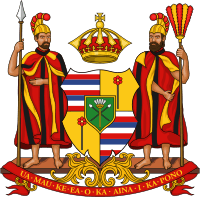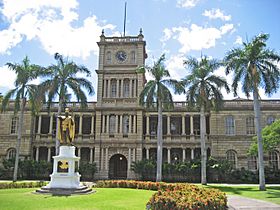Legislature of the Hawaiian Kingdom facts for kids
Quick facts for kids Legislature of the Hawaiian Islands1Legislative Assembly of the Hawaiian Kingdom2 |
|
|---|---|

Coat of arms of the Hawaiian Kingdom from 1845 to 1893
|
|
| Type | |
| Type |
Bicameral (1840–1864, 1887–1893)
Unicameral (1864–1887) |
| Houses | House of Nobles3 House of Representatives3 |
| History | |
| Established | 1840 |
| Disbanded | 1893 |
| Preceded by | Council of Chiefs (ʻAha Aliʻi) |
| Succeeded by | Legislature of the Republic of Hawaii |
| Elections | |
|
House of Nobles voting system
|
Appointed by the monarch with the advice of the Privy Council |
|
House of Representatives voting system
|
Elected by popular vote |
| Meeting place | |
 |
|
| Aliiolani Hale, Honolulu | |
| Footnotes | |
| 1Name of Parliament from 1852 to 1864 2Name of Parliament from 1864 to 1893 3Structure in place from 1840 to 1864 |
|
The Legislature of the Hawaiian Kingdom (which means ʻAhaʻōlelo o ke Aupuni o Hawaiʻi in Hawaiian) was the main law-making group for the Hawaiian Kingdom. It was like a parliament or congress.
At first, it had two parts (this is called bicameral). Later, it changed to have only one part (this is called unicameral). The idea for a royal legislature first appeared in the 1840 Constitution. The 1852 Constitution was the first to call it the Legislature of the Hawaiian Islands. It also made the monarch (the king or queen) follow some rules that were more like a democracy. Before this, the rulers made decisions with a group called the Council of Chiefs (ʻAha Aliʻi).
Contents
How the Legislature Was Set Up
From 1840 to 1864, the Legislature had two separate parts. This was set up by the Constitutions of 1840 and 1852. It had a lower part called the House of Representatives and an upper part called the House of Nobles.
However, the 1864 Constitution changed this. It got rid of the two-part system and created a single-part (unicameral) Legislature.
The House of Nobles
The members of the upper House of Nobles (Hale ʻAhaʻōlelo Aliʻi) were chosen by the Monarch. The Monarch would ask for advice from a special group called the Privy Council. This House also acted like a court. It could decide if any royal official should be removed from their job.
Most members were Hawaiian aliʻi (chiefs), nobles, or very wealthy people. They did not get paid for this job. Originally, the House included the King or Queen, plus five women and ten men. After the Hawaiian Kingdom was overthrown and later became part of the United States in 1898, this group changed. It became like a Senate under the rules for the Territory of Hawaii.
The House of Representatives
The members of the lower House of Representatives (Hale ʻAhaʻōlelo Makaʻāinana) were chosen by the people. They were elected through popular vote from different areas of the Kingdom.
This House was in charge of creating bills about money and taxes. It also acted as the "grand inquest" for the Kingdom. This meant it could investigate important matters.
History of the Legislature
The Legislature started as a two-part (bicameral) system from 1840 to 1864. But with the 1864 Constitution, it became a single-part (unicameral) legislature for a while.
This 1864 Constitution also added rules about who could be a member of the Legislature and who could vote. People had to own a certain amount of property and be able to read and write. These rules were later removed by the Legislature in 1874, during the time of King Lunalilo.
The next important change came with the 1887 Constitution. This brought back the two-part system. The upper House of Nobles was now elected for six-year terms, and members needed to own even more property.
After 1893, when the Hawaiian Kingdom was overthrown, this law-making body became the Legislature of the short-lived Republic of Hawaii. Then, in 1898, after Hawaii became part of America, it became the Legislature for the Territory of Hawaii.
Sixty-one years later, in 1959, Hawaii became the 50th U.S. state. The current Hawaii State Legislature was then formed. It still has two parts: the lower Hawaii House of Representatives and the upper Hawaii Senate. This is the law-making body for the State of Hawaii today, following the 1959 Hawaii Admission Act and the Constitution.
Leaders of the House of Nobles
Here are some of the people who led the House of Nobles:
- Kamehameha III (King, 1840–1851)
- Keoni Ana (1852–1854)
- Lot Kamehameha (1855)
- Keoni Ana (1856)
- Mataio Kekūanāoʻa (1858–1860)
- Lot Kamehameha (1862)
Speakers of the House of Representatives
These individuals served as the Speaker, or leader, of the House of Representatives:
- William Little Lee (1851)
- George Morison Robertson (1852–1853)
- Asa Goodale Tyerman Thurston (1854)
- George Morison Robertson (1855–1856)
- George Morison Robertson (1858–1859)
- James W. Austin (1859)
- Lawrence McCully (1860)
- William Webster (1862)
Presidents of the Legislature
When the Legislature became a single body, these people served as its President:
- Mataio Kekūanāoʻa (1864–1868)
- Paul Nahaolelua (1870–1874)
- Charles Reed Bishop (1874)
- Godfrey Rhodes (1876–1878)
- Charles Reed Bishop (1880)
- Godfrey Rhodes (1882–1884)
- John Smith Walker (1886)
- Samuel Gardner Wilder (1887)
- William Richards Castle (1887)
- Samuel Gardner Wilder (1888)
- William Richards Castle (1888)
- John Smith Walker (1890–1893)
Vice-Presidents of the Legislature
These individuals served as the Vice-President of the Legislature:
- Samuel Northrup Castle (1864)
- Godfrey Rhodes (1866)
- John Mott-Smith (1867), pro tempore (meaning for a short time)
- Godfrey Rhodes (1868)
- Harvey Rexford Hitchcock Jr. (1870)
- David Howard Hitchcock Sr. (1872–1873)
- Simon Kaloa Kaʻai (1874)
- Luther Aholo (1876–1886)
- John Kauhane (1887–1893)

